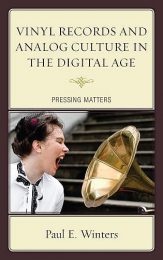Not just the die-hard fans and collectors of vinyl recordings will be interested in this new book by Paul E. Winters. Since actually the whole idea of conserving the products of popular culture (which includes recorded sound and music) is carefully examined here.
 This goes along with analysis of the marketing ideas and promises used by the industry that had to make modern audio playback technology interesting. “Along with sound being sold to the listening subject an object, the illusion of control over these objects was also sold as an important property of subjectivity.”
This goes along with analysis of the marketing ideas and promises used by the industry that had to make modern audio playback technology interesting. “Along with sound being sold to the listening subject an object, the illusion of control over these objects was also sold as an important property of subjectivity.”
In a blend of academic and technical research, the long story of recorded audio from Edison’s cylinder, shellac, vinyl and finally simple digital data as well as “high fidelity” is thoroughly researched. Since vinyl as a carrier of information technology should have vanished long ago, if the industry had had the final word. But, as the book’s title already suggests, there has been a strong vinyl renaissance that started in the late 1990s. It let prices for rare LPs explode and that for the last few years almost stopped the slow death of second-hand record stores all over the world.
Winters researched the many different strategies vinyl collectors follow to build up their personal archive or how these routines provide a foundation (and monetary value) for certain products of the recording industry. Since vinyl collecting then may become an obsession, as exclusive and rare items of any sort also produce their own followers, collectors and experts; only in this case anything digital, such as the stream, the CD, MP3 file or the play list simply has no value at all. Analog technology is what counts, even if all vinyl reissues produced nowadays use digital masters.
The very nature of recorded audio on vinyl, its haptic properties and the idea that a vintage record sold some decades ago over some counter today has developed a sort of maturity, identity, and is unique in its own way, even if the LP was originally produced in the ten thousandfold.
Furthermore, the questions of “authenticity” matter quite a bit, since even the vinyl recordings of new artists seemingly have a better “authentic credibility” than their CD brethren. Psychological and sociological motivations are taken into consideration and some intriguing conclusion about the record collector as a very particular “specimen” are suggested here.
The author employs songs and marketing stratgies of The Beatles (who started out as artists originally publishing in mono on vinyl, then in stereo, then on CD, only to be reissued in 2014 on vinyl with ten whole albums in mono again) to prove the many ways an audio recording can represent certain values of popular culture. To represent those at a certain time and describe it as the present-day superior product, and that it stands for positive aesthetic values. (Provided that this idea is promoted strong enough by the industry, that will make sure the new edition receives publicity in the major collector’s magazines and online).
His last chapters take a good look at the music (recording) industry that naturally is interested in satisfying both mainstream customers as well as record collectors and therefore invented limited vinyl (re)editions and the like, to market a mass product in the shape of a seemingly rare and very exclusive item. And how audiophiles conceive of themselves with respect to technology and maximum audio reproduction, while the final section of the book is devoted to the role of information technology and the Internet. Those technical developments, on the one hand, resulted in the introduction of the audio CD and streaming music, but also kept a huge network of audiophiles, vinyl collectors and music experts alive.
Here we have a good study on many characteristics of not just vinyl collecting but on the nature, “aura,” authenticity and meaning of this important intellectual and artistic product; which, nevertheless, remains a product that, according to the very nature and purpose of the music industry, needs to be promoted and sold to generate revenue. So, all in all, here we witness a discussion about aesthetic claims from various sides.
We have to keep in mind that the fresh huge request for music on vinyl is a development that “should not” have happened (while the entire music sale of vinyl is just 1%) from the perspective of the music industry. For it invested massively in digital technologies in terms of (cheaper) production and (cheaper) distribution; instead, the consumption, collection and hunt for vinyl (new and vintage) currently keeps reaching new peaks every year.
Very informative and not too academic in nature, this text will appeal to vinyl collectors and researchers of popular culture and consumer culture as well.
Review by Dr. A. Ebert © 2016
Paul E. Winters. Vinyl Records and Analog Culture in the Digital Age: Pressing Matters. Lexington Books, 2016, 208 p.
